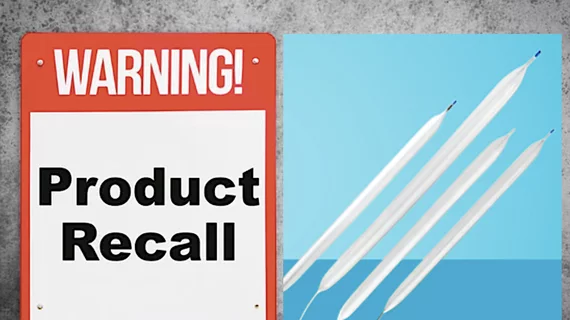Patient deaths and injuries prompt Teleflex to recall intra-aortic balloon catheters
Three patient deaths, 31 injuries and 322 complaints led to a U.S. Food and Drug Administration Class 1 recall of Teleflex/Arrow International FiberOptix and UltraFlex intra-aortic balloon pump (IABP) catheter kits.
The recall includes 16,959 devices distributed between May 7, 2022 and April 8, 2024. The company initiated the recall April 29, 2024.
The vendor said a manufacturing error may cause the catheter’s balloon to become over twisted. This issue may prevent the balloon from fully inflating, cause blood to back up in the tubing, allow helium to leak, and lead to catheter damage or insertion difficulty during use, according to the recall notice.
Use of this device may cause serious injury, including blood loss, artery perforation, hemodynamic instability, myocardial ischemia, or death, the FDA said.
The issue can sometimes be identified visually, but not always. As such, the vendor suggests following all the mitigations outlined in the recall.
The Arrow FiberOptix and Arrow UltraFlex Intra-Aortic Balloon Catheter Kits are used with a balloon pump in patients undergoing cardiac and non-cardiac surgery, and to treat adult patients who have acute coronary syndrome or complications of heart failure.
Teleflex IABP catheter recall notice instructions
Teleflex/Arrow International sent an urgent medical device notification letter to customers April 29, 2024, that included the following recommended actions:
• Ensure that a back-up intra-aortic balloon catheter is available before using this device, in case a replacement is needed.
• Inspect all intra-aortic balloon catheters in the scope of this recall for signs of an over-twisted balloon wrap or bent balloon shaft before use.
• Over-twisting manifests as a progressive pitch or tightness within the helical wrap at either the distal or proximal end of the balloon.
• Do not insert catheters suspected of manifesting an over-twisted wrap. The company warns not all affected catheters will show a visibly over-twisted balloon wrap.
• Use fluoroscopic guidance to insert all intra-aortic balloon catheters in the scope of this recall.
Once inserted and connected, fluoroscopy must be used to assess the completeness of balloon inflation. Fluoroscopic assessment must span the full length of the balloon (panning as necessary) and should include several cycles of inflation/deflation.
• Intermittent fluoroscopy should remain available for up to three minutes after one-to-one cyclic counterpulsation begins, or until full balloon inflation is confirmed.
• Be vigilant in responding to pump alarms consistent with the instructions for use and users guide.
If an Arrow AC3 or Autocat-2 pump is being used, a high-pressure alarm or high baseline alarm may sound and display on the pump console. These red-condition alarms require immediate attention. The alarms provide users with a trouble shooting algorithm that includes incomplete IAB inflation.
• If a Getinge CardioSave pump is being used, an IAB catheter restriction alarm may sound.
• Any pump alarm indicating helium leakage may signal the IAB catheter is not performing as expected.
Other bedside indicators that an intra-aortic balloon catheter is not performing as expected include:
• Blood in the helium pathway
• Lower than expected diastolic pressure augmentation
If this issue is identified or suspected, Teleflex instructs users to immediately remove the catheter and replace it. A replacement balloon catheter may be inserted contralaterally or ipsilaterally as determined by the responsible physician after considering the patient’s individual femoral access options and relevant clinical features, the company said.
The company also asks users to promptly report every suspected issue that may be related to this recall as soon as is practical. The vendor said local sales representatives can also assist with completing a report if needed.
More details on the recall including specific product codes and company contact information

